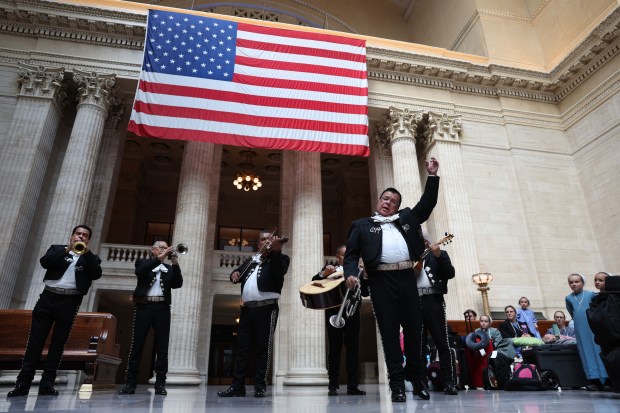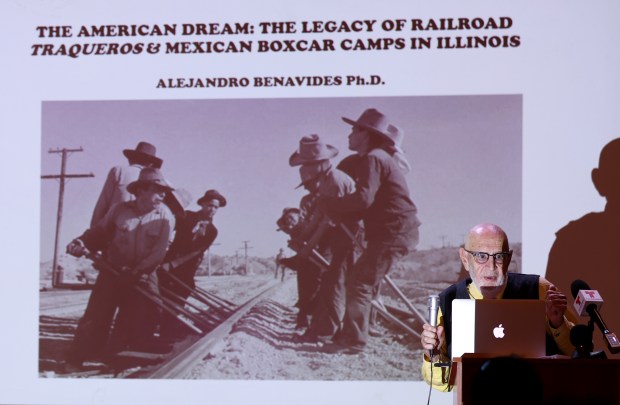When train travel expanded into Illinois in the 1800s, it was the lowest ranking employees who laid the rails, which could weigh close to half a ton. To keep the trains running on time through the winter, they’d light fires to thaw the tracks.
Called “traqueros,” a term derived from the Spanglish word traque, which means track, these Latino workers were honored by Amtrak on Wednesday in Union Station.
The ceremony was the brainchild of Ismael Cuevas, a government affairs manager for Amtrak, who began researching the history of the workers after spotting a historical marker about a Mexican village upon arriving in Dodge City, Kansas, on the Amtrak Southwest Chief train from Chicago.
The village was formed more than a century ago, said Cuevas, who has Mexican ancestry.
“This village was actually a cramped, temporary boxcar camp community of traqueros working for the Santa Fe railroad near the (railway) roundhouse in Dodge City,” Cuevas said.
Forgetting the precise definitions of “traquero” and “boxcar camp,” Cuevas googled the terms. After refreshing himself on what traqueros did, Cuevas learned boxcar camps were communities of mobile homes that could be moved by rail and placed on railroad siding, nearby the main tracks, for weeks or months.
The mobile homes were made out of old boxcars — enclosed railway cars used to carry freight. Immigrants converted boxcars into homes by adding kitchens, porches and gardens, Cuevas said.
“Can you imagine living in a boxcar community here in Chicago in the winter without heating, proper insulation, proper weatherproofing?” Cuevas said.
Cuevas, who has worked for Amtrak for about two years, said after looking up these definitions, he then wondered how Mexicans and other Latinos ended up working on the railroad in the first place.
At the ceremony, Amtrak recognized Latinos, who laid much of the nation’s railroad tracks, with a Mariachi band that entertained Amtrak customers camped out on long wooden benches in the station’s Great Hall.
Later, in the station’s Burlington Room, a space once used as a women’s waiting room and beauty parlor, an Aurora-based historian delivered a talk on rail history and current Latino Amtrak employees spoke about forebearers who worked in the industry.
The ceremony honored traqueros of all kinds, including 19th century Mexican and Mexican American laborers who helped expand the railroad across the country, as well as Latino men and women who work for the railroad today.
Life on a crew of track workers during the late 19th and early 20th centuries often involved picking up iron rails and setting them in position. A 19-foot rail could weigh more than 900 pounds, said historian Alejandro Benavides. Crews might be able to lay 10 miles of track a day, he added.
White rail workers supervised Latino members of track-laying crews. Though traqueros were the lowest ranking rail employees, actually laying the track was the “most essential job” in the railroad business, Benavides said.
In addition to laying tracks, rail workers maintained existing ones. During winter in places such as Illinois, traqueros used fire to thaw tracks, according to Benavides.
“They were the ones that regardless of the weather — rain, snow, cold, blistering heat — traqueros were assigned to make sure that the … trains ran and they ran on time,” Benavides said.
According to Cuevas, the supply of Chinese immigrant labor, which was key to the completion of the first transcontinental railroad in 1869, decreased after the passage of the Chinese Exclusion Act in 1882. Railroad companies filled the labor void by hiring Mexican workers.
Between 1880 and 1930, Mexican track workers made up nearly two-thirds of the track labor force in the Southwest, Great Plains and Midwest, according to a 2016 book on traqueros, Cuevas said.
Benavides, author of a historical fiction book set in a boxcar camp that was located in Eola near Aurora, focused much of his talk on the camp, which opened in 1923 and housed Mexican immigrant track workers.

The job of the workers living at the Eola camp was to reduce locomotives to scrap metal for the Chicago, Burlington and Quincy Railroad.
Benavides showed the audience a photo of children at the camp playing near tracks — a hazardous location, but the only place they could play.
“This is what the camp looked like — very stark, no trees, no flowers, just living right by the railroad tracks,” Benavides said.
The Eola camp closed in the mid-1930s. About 20 boxcar camps existed in Illinois, Benavides said.
Eddie Pavon, a locomotive machinist technician at Union Station, was one of the Latino Amtrak workers who spoke about family ties to the railroad industry. Pavon said his father, a Puerto Rican, retired from Amtrak in 2019 after working on the railroad for more than 41 years.
“He taught me how to perform an air brake departure test before the training department even scheduled us to do so,” Pavon said. “He was eager to teach those who were serious about learning because dad’s time was extremely important to him.”
Cuevas concluded the ceremony by reading a resolution recognizing Amtrak’s celebration of its Latino workforce, which the Chicago City Council passed Wednesday.




